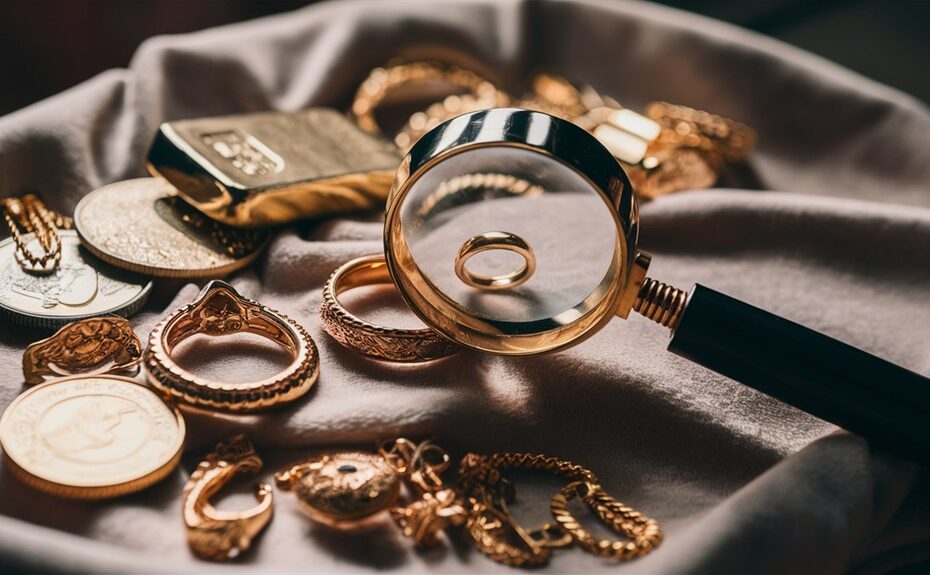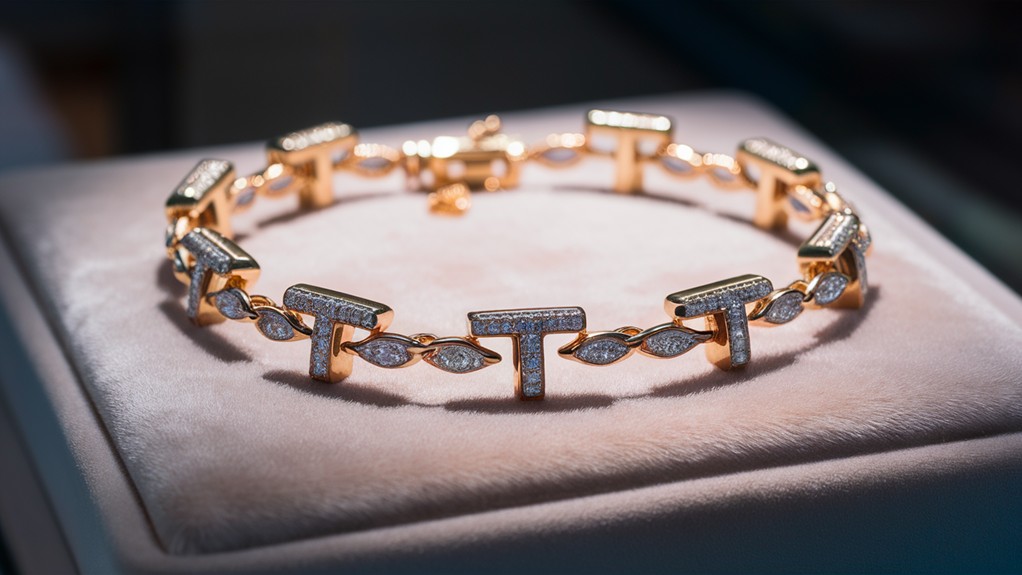As you consider investing in gold jewelry in 2024, you'll find that understanding the market's subtleties is essential. With a projected growth rate of 7.5% CAGR, the gold jewelry sector offers promising opportunities. However, maneuvering the world of precious metal investments requires more than just following trends. You'll need to grasp gold purity standards, evaluate craftsmanship, and time your purchases strategically. But that's just the beginning. To truly enhance your investment potential, you'll want to investigate the intricate balance between aesthetic value and market demand. So, what's the key to making informed decisions in this glittering market?
Our Highlighted Points
- Focus on higher karat gold (18K or 24K) for better investment value and resale potential.
- Consider the spot price of gold as a baseline, but factor in craftsmanship and design for overall value.
- Purchase from reputable sellers and obtain certifications to ensure authenticity and quality.
- Diversify your portfolio with a mix of investment-grade and unique, culturally significant pieces.
- Stay informed about market trends and regularly appraise your collection to maximize long-term value.
Understanding Gold Purity Standards
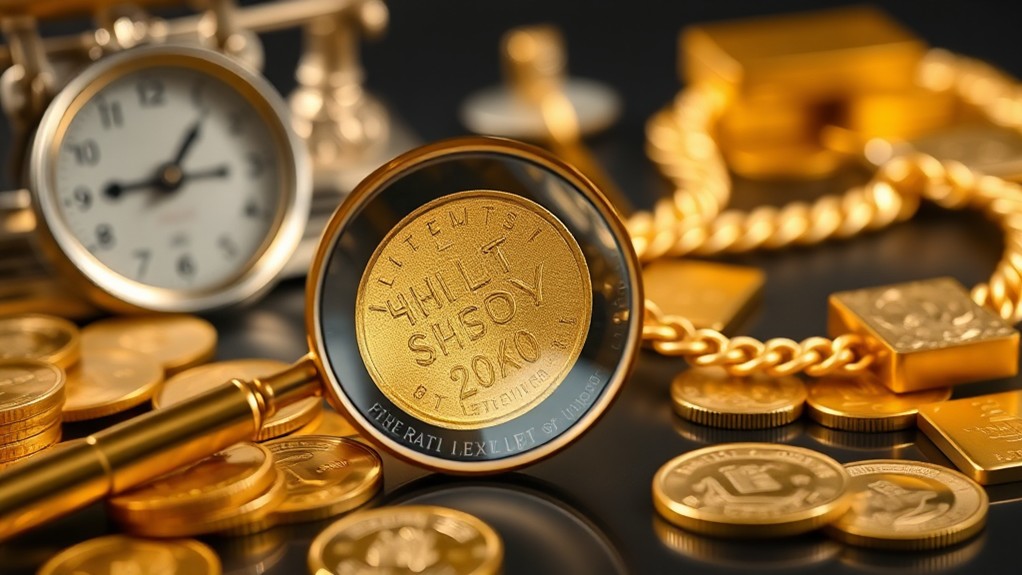
When you're considering investing in gold, understanding purity standards is vital. Gold purity is measured in karats (K), with 24K representing the highest level of purity at 99.9%. As you investigate jewelry standards, you'll encounter common options like 10K, 14K, and 18K, each containing progressively higher percentages of gold.
For investment purposes, focus on "fine gold," which refers to gold with a purity of 0.999 or higher. This high-quality gold is typically used in investment-grade products such as bullion coins and bars.
When evaluating jewelry, remember:
- 18K gold contains 75% pure gold
- 14K gold consists of about 58.3% gold content
- 10K gold has the lowest gold content among common jewelry standards
To guarantee transparency, U.S. regulations require gold jewelry to be stamped with its purity level. This helps you identify the quality and value of your potential purchase.
Keep in mind that different countries may have varying regulations regarding gold purity standards, so it's important to familiarize yourself with local requirements when investing in gold internationally.
Market Trends in Gold Jewelry
As you investigate the world of gold jewelry investment, it's crucial to stay on top of market trends. The global gold jewelry market, valued at $228 billion in 2022, is projected to grow at a 7.5% CAGR through 2030. This growth is primarily driven by rising disposable incomes and demand in emerging markets.
Key market trends to keep in mind:
1. Regional dominance: India and China account for over 50% of global demand, highlighting the cultural significance of gold in these countries.
2. Sustainable and ethical sourcing: Consumers increasingly prioritize environmentally and socially responsible gold jewelry.
3. Price factors: The price of gold jewelry is influenced by:
- Fluctuating gold spot prices
- Craftsmanship and design complexity
- Brand reputation
4. Seasonal demand: Gold jewelry prices often surge during festive seasons and weddings, particularly in countries with rich cultural traditions.
To enhance your investment potential:
- Research emerging markets for growth opportunities
- Keep in mind sustainable and ethically sourced gold options
- Monitor seasonal trends to time your purchases strategically
- Evaluate pieces based on craftsmanship and design, not just gold content
Evaluating Craftsmanship and Design

Expertise in evaluating craftsmanship and design is vital for making informed gold jewelry investments. When examining a piece, look for signs of quality in the manufacturing process, such as even solder joints, smooth edges, and consistent finishes. These indicators demonstrate attention to detail and superior craftsmanship.
Check the hallmark or stamp, which not only reveals the gold content (e.g., 14K, 18K, or 24K) but likewise identifies the manufacturer. This information can be a marker of quality craftsmanship. Assess the piece's weight; substantial heft often indicates higher gold content and better general quality.
Evaluate the design's intricacy and artistic elements. Well-executed, unique designs tend to reflect higher craftsmanship and can improve the jewelry's appeal and value. Pay attention to settings that securely hold gemstones, as these require skilled artisanship to balance aesthetics and durability.
| Aspect | Quality Indicators |
|---|---|
| Manufacturing | Even joints, smooth edges |
| Hallmark | Purity stamp, maker's mark |
| Weight | Substantial, not lightweight |
| Design | Intricate, unique, coherent |
| Settings | Secure, well-balanced |
Pricing Factors for Gold Jewelry
The price tag on gold jewelry reflects a complex interplay of factors. Understanding these elements is essential for developing a sound investment strategy:
1. Gold Price: The foundation of jewelry pricing is the current spot price of gold, which fluctuates based on market conditions. As of September 2020, prices averaged around $1,900 per ounce.
2. Purity and Karats: Gold content, measured in karats, greatly impacts pricing:
- 24K: 99.9% pure gold
- 18K: 75% gold content
- 14K: 58.3% gold content
3. Weight: Heavier pieces command higher prices because of increased gold content. Pricing is typically calculated per gram or ounce.
4. Premium: Jewelry often sells at a markup above the spot price, ranging from 50% to 300%, reflecting:
- Craftsmanship
- Brand value
- Design complexity
5. Market Fluctuations: Gold prices are subject to economic shifts, affecting both purchase and resale values.
6. Resale Market: When selling gold jewelry, expect lower prices than retail because of dealer markups and market volatility.
To enhance your investment, consider these pricing factors carefully, balancing aesthetic appeal with potential long-term value.
Reputable Sellers and Certifications
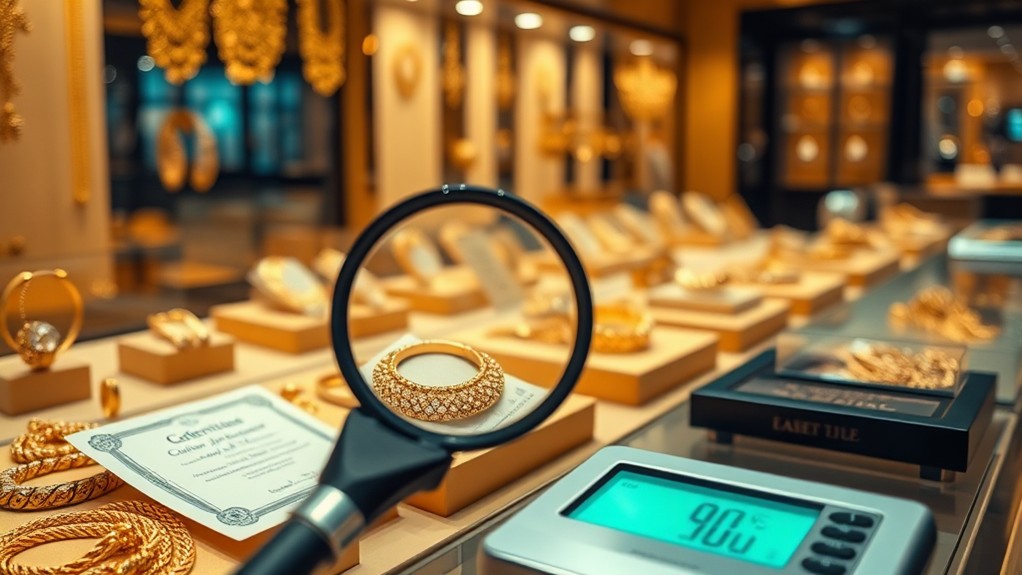
Understanding pricing factors is just the initial step in gold jewelry investment. Regarding purchasing gold jewelry, it's critical to buy from reputable sellers who can provide assurances of quality and authenticity. Look for sellers with clear business histories, customer reviews, and return policies. Certifications from recognized organizations like the Gemological Institute of America (GIA) or International Gemological Institute (IGI) are fundamental for verifying the quality of your purchase.
Confirm that your gold jewelry is marked with a karat stamp (e.g., 14K, 18K, or 24K) indicating the gold purity level. This is a legal requirement in many countries and helps you validate the authenticity of your investment. Reputable sellers should likewise provide a certificate of authenticity detailing the gold's weight, purity, and any gemstones.
| Certification | Significance | Authenticity | Trust |
|---|---|---|---|
| GIA | High | Verified | Strong |
| IGI | High | Verified | Strong |
| Karat Stamp | Fundamental | Legal Req. | Critical |
| Certificate | Significant | Detailed | Secure |
Consider purchasing from well-established retailers or jewelers who are members of industry organizations such as the Jewelers of America (JA). These associations guarantee adherence to ethical and quality standards, providing you with additional peace of mind while investing in gold jewelry.
Investment-Grade vs. Decorative Pieces
Distinguishing between investment-grade and decorative gold pieces is crucial for savvy investors.
Investment-grade gold typically refers to pieces with a purity of 0.999 fine gold, making them suitable for investment purposes. These items maintain their value based on the current gold spot price, offering greater liquidity and resale potential.
On the other hand, decorative jewelry often includes gemstones and intricate designs that can markedly raise their retail price. However, this added value doesn't necessarily translate into investment value, as it may not be recoverable when selling.
Decorative pieces may likewise have lower purity and are often valued more for their craftsmanship than their gold content.
When considering gold for investment:
- Prioritize investment-grade gold with certified purity
- Limit decorative jewelry to a small portion of your precious metals portfolio
- Obtain certification verifying the piece's authenticity for investment-grade items
- Be aware that decorative pieces may depreciate unless they're highly sought-after collectibles
Storage and Insurance Considerations
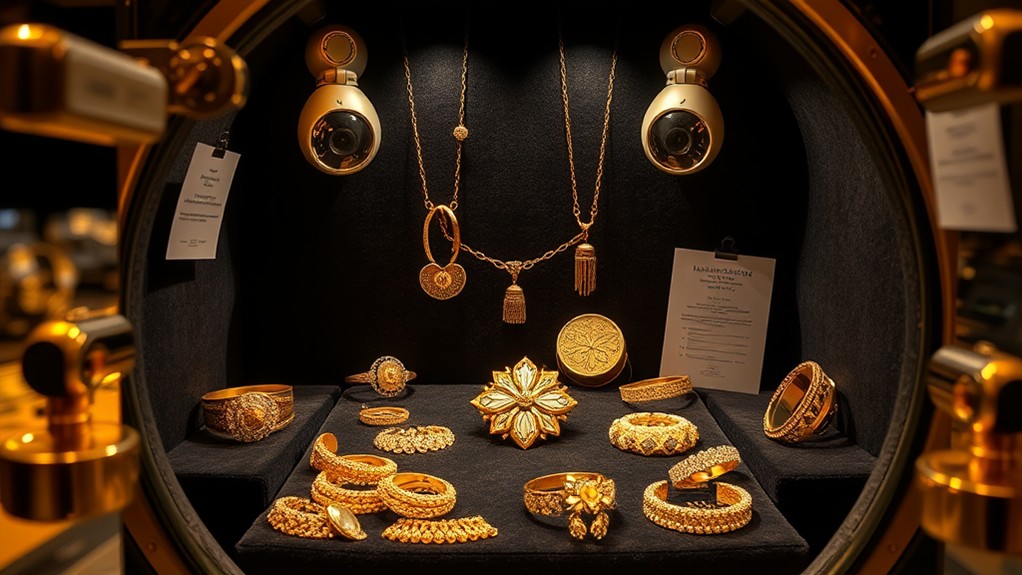
Once you've acquired your gold investments, whether investment-grade or decorative pieces, protecting your assets becomes essential. To safeguard your precious metal jewelry, consider these storage and insurance options:
- Home Storage:
- Invest in a fireproof safe ($100-$1,000)
- Confirm it's waterproof for added protection
- Bank Safe Deposit Box:
- Annual fees range from $30 to several hundred dollars
- Offers improved security for valuable pieces
- Insurance:
- Homeowners insurance may not provide full coverage
- Obtain specialized jewelry insurance for thorough protection
- Regularly appraise your jewelry every 2-3 years to maintain accurate valuation
- Record Keeping:
- Maintain meticulous records of purchases and appraisals
- Document insurance policies for easy claims processing
When selecting storage options, prioritize theft protection and damage prevention.
For insurance, verify your coverage reflects the current market value of your pieces.
By implementing these measures, you'll safeguard your investments against potential losses and maintain their value over time.
Resale Value and Liquidity
In relation to gold jewelry, its resale value and liquidity can be tricky to navigate. When considering gold jewelry as an investment, it's vital to understand that its resale value often differs considerably from the original purchase price. This discrepancy is typically influenced by the current market price of gold, minus dealer markups or premiums.
While gold jewelry isn't considered a highly liquid asset, you can take steps to optimize its potential resale value and improve liquidity.
To boost your gold jewelry's investment potential:
- Focus on high-quality pieces with unique designs or historical significance
- Retain original receipts, certificates of authenticity, and appraisals
- Stay informed about market trends and economic conditions affecting gold prices
- Consider designer pieces or those from reputable brands
Remember that factors such as craftsmanship, brand reputation, and market demand can considerably impact resale value.
While the inherent value of gold is based on weight and purity, jewelry pieces may command higher prices owing to their aesthetic or historical value. By carefully selecting and documenting your gold jewelry investments, you'll be better positioned to optimize returns and improve liquidity when it's time to sell.
Diversifying Your Jewelry Portfolio
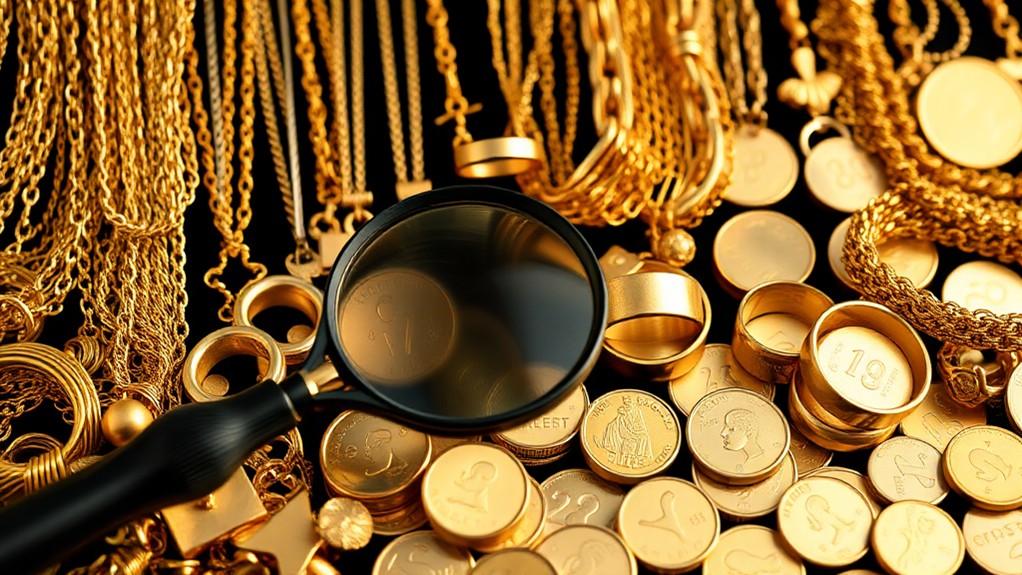
Building on the strategies for optimizing resale value, it's crucial to consider broadening your jewelry portfolio. To achieve this, think about incorporating different types of gold jewelry, including:
- 14k, 18k, and 24k pieces, each offering different purity levels and price points
- Unique pieces from diverse cultures or historical periods
- Gemstone-encrusted gold jewelry
- Limited edition or designer gold jewelry
By broadening your portfolio, you're not only spreading risk but also potentially increasing your investment's total value. Unique pieces can appreciate over time, offering both financial and storytelling benefits.
Gemstone-encrusted gold jewelry adds another layer of value, as certain gemstones may retain or increase in worth independently of gold prices.
Limited edition or designer gold jewelry serves a dual purpose as both an investment and a collectible. These pieces often command higher resale values because of brand reputation and rarity.
To stay informed about market trends and make sound decisions, regularly appraise your jewelry portfolio. This practice will help you determine when to buy, sell, or hold specific pieces, ensuring your precious metals investment remains strong and aligned with current market conditions.
Timing Your Gold Jewelry Purchases
When should you make your gold jewelry purchases to improve value? Timing is essential when adding gold to your investment portfolio. By monitoring gold price trends and economic factors, you can make informed financial decisions that optimize your investment's potential.
Gold prices typically decline in late spring and early summer, offering an opportune time to buy. Furthermore, consider these strategies to refine your purchases:
- Take advantage of seasonal sales events, such as Black Friday or post-holiday sales, when retailers offer significant discounts.
- Buy during off-peak wedding seasons (November to March) when demand decreases, leading to better deals.
- Attend jewelry trade shows or exhibitions for promotional pricing and exclusive collections.
- Keep an eye on local and global economic uncertainty, as gold prices tend to rise during unstable periods.
Frequently Asked Questions
What Is the Best Precious Metal to Invest in In 2024?
You'll find gold remains the top choice for precious metal investment in 2024. It's a reliable safe-haven asset. However, consider plunging into silver and platinum to balance your portfolio and potentially capture different market opportunities.
Is 2024 a Good Time to Buy Gold?
You'll find 2024 could be a good time to plunge into gold. With economic uncertainties and geopolitical tensions, gold's appeal as a safe-haven asset may increase. However, you should carefully monitor market trends and diversify your investments accordingly. One way to invest in gold is through physical gold coins. When considering which coins to purchase, it’s important to do thorough research and consider factors such as purity, weight, and reputation of the mint. Some top gold coins for 2021 to consider include the American Eagle, Canadian Maple Leaf, and South African Krugerrand. These popular coins are widely recognized and easily tradable, making them a solid choice for investors looking to add gold to their portfolio.
Does Dave Ramsey Recommend Investing in Gold?
Dave Ramsey doesn't generally recommend investing heavily in gold. He suggests it should only be a small part of your portfolio, if at all. Instead, he advises focusing on growth-oriented investments like stocks and mutual funds for long-term wealth building.
What Is the Best Asset to Invest in Gold?
You'll find gold bullion coins like Canadian Maple Leafs or Krugerrands are top choices for gold investment. They're highly pure and liquid. For larger investments, gold bars offer lower premiums. ETFs provide easy exposure without physical ownership.
